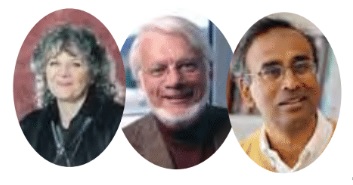- History Home
- People, Leadership & Service
- A Legacy of Excellence
- History & Impact
- Meetings Through the Years
- Resources
|
The 2009 Nobel Prize in Chemistry to Ada Yonath, Thomas Steitz and Venkatraman Ramakrishnan RefleXions, Winter 2009 Ada Yonath, Thomas Steitz and Venkatraman Ramakrishnan were born over a decade apart in different parts of the world. They had different childhoods and role models, but over the years, their lives moved closer and closer together. The direction of their movement was toward structurally mapping the ribosome at the atomic level. This was no small feat. The ribosome is one of the cell's most complex machineries, consisting of dozens of proteins and RNA molecules several hundred nucleotides in length. Ada Yonath (Weizmann Institute of Science) pioneered ribosome crystallography in the late 1970s. By 1990, through the application of cryo-crystallography, she was able to produce detailed diffraction maps from her crystals. Others joined the pursuit in the mid-90s, including ACA member Thomas Steitz (Yale) and Vekatraman Ramakrishnan (MRC Laboratory of Molecular Biology). In 1998, Steitz, with Yale colleagues Peter Moore and Joachim Frank (Columbia University) used electron microscopy studies to interpret the diffraction maps and produce a low-resolution 9 Å structure of the larger 50S ribosomal subunit. In the year 2000, their paths converged. In August of that year Steitz published a high-resolution structure of the 50S subunit. This was followed by structures of the smaller 30S subunit published independently by Yonath and Ramakrishnan the following month. At the same time, in a second paper by Ramakrishnan's group, the structures of the 30S subunit in complex with three antibiotics that target different regions of the subunit and the structural basis for the action of each was revealed. The first crystal structure of the complete ribosome was reported a year later by Harry Noller (UC Santa Cruz). Both Steitz's and Yonath's groups have since published antibiotic-bound structures. This year, the names of Ada Yonath, Thomas Steitz and Venkatraman Ramakrishnan will be forever tied together in history as co-recipients of the 2009 Nobel Prize in Chemistry. From diverse origins and following different routes, their paths have reached what some describe as the highest honor for scientific achievement. However, many, including the winners, have noted that the Nobel Committee's self-imposed rule limiting each prize to no more than three recipients is a shortcoming. They have stated that the work of many others, especially those named above, in contributing to "the studies of the structure and function of the ribosome" for which the prize was granted should not go unnoticed. |

